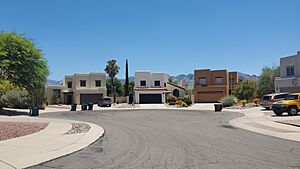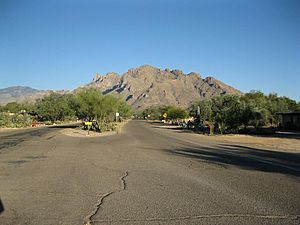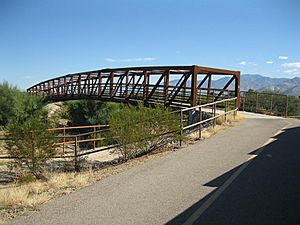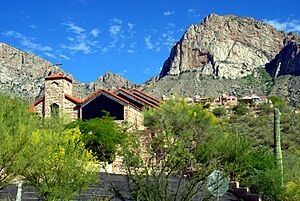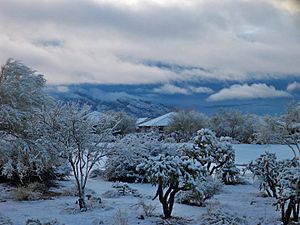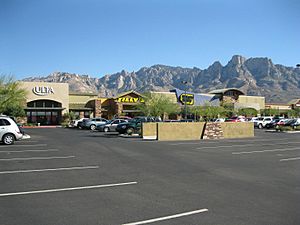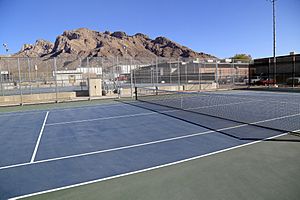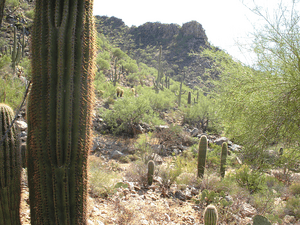Oro Valley, Arizona facts for kids
Quick facts for kids
Oro Valley, Arizona
|
|||
|---|---|---|---|
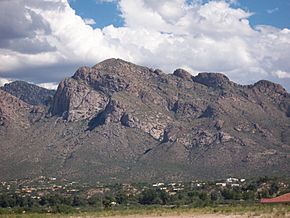
View of Pusch Ridge in the Santa Catalina Mountains from Oro Valley, September 2004
|
|||
|
|||
| Nickname(s):
The OV
|
|||
| Country | United States | ||
| State | Arizona | ||
| County | Pima | ||
| Founded | 1974 | ||
| Incorporated | 1974 | ||
| Government | |||
| • Type | Council-manager | ||
| • Body | Oro Valley Town Council | ||
| Area | |||
| • Total | 34.99 sq mi (90.63 km2) | ||
| • Land | 34.87 sq mi (90.32 km2) | ||
| • Water | 0.12 sq mi (0.30 km2) | ||
| Elevation | 2,620 ft (798.57 m) | ||
| Population
(2020)
|
|||
| • Total | 47,070 | ||
| • Density | 1,349.72/sq mi (521.13/km2) | ||
| Time zone | UTC-7 (MST (no DST)) | ||
| ZIP codes |
85704, 85737, 85742, 85755
|
||
| Area code(s) | 520 | ||
| FIPS code | 04-51600 | ||
| GNIS feature ID | 37458 | ||
Oro Valley is a town in Arizona, USA. It's about 6 miles (9.7 km) north of Tucson. The town was officially started in 1974. In 2020, about 47,070 people lived there.
Oro Valley is known as a "Tech Mecca" because it has over 10 high tech companies. Many people who live here have a higher income than the average in the U.S. The town is located near the Santa Catalina Mountains and Pusch Ridge. It's also a popular spot for people to have second homes, especially in the winter.
The town hosts many cool events. These include the Oro Valley Festival of the Arts, the El Tour de Tucson bicycle race, and the Oro Valley Music Festival. There's also the Tucson Marathon and the Oro Valley Triathlon.
Contents
History of Oro Valley
Early People and Spanish Explorers
People have lived in the Oro Valley area for almost 2,000 years. The Native American Hohokam tribe lived in Honeybee Village around 450 A.D. They stayed there for about 800 years. Archaeologists still study the artifacts found from their village.
Later, in the 1500s, the Apache tribes arrived in southern Arizona. Soon after, Spanish explorers, like Francisco Coronado, came to the area. The Spanish built forts, including the Presidio at Tucson in 1775.
Arizona Territory: Ranchers and Homesteaders
In the 1800s, more Americans moved to the Arizona Territory. This happened after the Mexican–American War and the Gadsden Purchase. After the Civil War, settlers from Tucson started moving north to Oro Valley.
Francisco Romero started a ranch in what is now Catalina State Park in 1869. He built his ranch on old Hohokam ruins. His family lived in the area until 1930.
George Pusch, an immigrant from Germany, started a cattle ranch in Oro Valley after 1874. His ranch was special because it used a steam pump for water. This made his property, called Steam Pump Ranch, very famous. Pusch Ridge is named after George Pusch.
More ranches grew in the area as Arizona became a state. People could claim federal homesteads after 1903. Many different people, including Hispanic families and women, claimed land. Wealthy families from other parts of the U.S. also bought large ranches between 1930 and 1960. They often lived there in the winter.
Some people came looking for gold, hoping to find the legendary Iron Door Gold Mine in the Santa Catalina Mountains. However, not much gold was found in the area.
Growth After World War II
After World War II, the Tucson area, including Oro Valley, grew a lot. New neighborhoods started to be built in the 1930s. Campo Bello, the first suburban area, began construction in 1948. The Oro Valley Country Club opened in the early 1950s, showing the area was becoming a wealthy community.
Becoming an Official Town
As the community grew, people wanted more control over their local area. In the late 1960s, residents wanted Oro Valley to become its own town. The mayor of Tucson wanted to expand Tucson to include Oro Valley, but residents didn't want that.
A group of citizens started a petition in 1968 to make Oro Valley a town. After some legal battles, the Arizona Supreme Court agreed. In 1974, Oro Valley officially became a town. It started with about 1,200 people.
Through the 1980s and 1990s, Oro Valley grew very fast. In 1990, the population was 6,670, and by 2000, it was 29,700. Many new neighborhoods and planned communities were built. For several years in the 1990s, Oro Valley was the fastest-growing town in Arizona.
Today, the Oro Valley Historical Society works to save the town's history for future generations.
Geography and Nature
Oro Valley is located at an average height of 2,620 feet (798.57 m) above sea level. The town is split by the Cañada del Oro riverbed. To the east, the land rises steeply to the Santa Catalina Mountains. To the west, it rises more gently towards the Tortolita Mountains.
Important natural spots in Oro Valley include:
- Pusch Ridge and Pusch Ridge Wilderness Area
- Santa Catalina Mountains
- Cañada del Oro (a riverbed)
- Tortolita Mountains
Parks and Outdoor Fun
Oro Valley has many great parks for outdoor activities. James D. Kriegh Park has an Olympic-sized swimming pool and sports fields. The Cañada del Oro Riverfront Park offers tennis, basketball, walking trails, and connections to horse trails. West Lambert Lane Park is a nature park with hiking trails.
Naranja Park is the largest park, covering 213 acres. It has sports fields, a playground, a dog park, and an archery range. It also has walking trails and is home to a club for radio control model aircraft. Recent upgrades added more sports fields, pickleball courts, basketball courts, a splash pad, a BMX track, and a skate park.
Catalina State Park and the Coronado National Forest are on the eastern side of Oro Valley. Linda Vista Trail offers amazing views of Oro Valley and Pusch Ridge.
The Oro Valley Historical Society helps maintain and share the history of two park sites:
- Honeybee Village (an ancient Native American site)
- Steam Pump Ranch (a historic ranch)
La Cholla Airpark is a private airport community in Oro Valley. It has nearly 100 homes and a 4,500-foot (1,372 m) airstrip for its members.
Climate
Oro Valley has weather similar to Tucson, but with a few differences. It gets a little less rain because it's west of the Santa Catalina Mountains. Temperatures are usually a bit cooler year-round due to the higher elevation. The sun also rises a little later because of the mountains.
| Climate data for Oro Valley,AZ | |||||||||||||
|---|---|---|---|---|---|---|---|---|---|---|---|---|---|
| Month | Jan | Feb | Mar | Apr | May | Jun | Jul | Aug | Sep | Oct | Nov | Dec | Year |
| Source: NOAA | |||||||||||||
Population and People
| Historical population | |||
|---|---|---|---|
| Census | Pop. | %± | |
| 1970 | 581 | — | |
| 1980 | 1,489 | 156.3% | |
| 1990 | 6,670 | 348.0% | |
| 2000 | 29,700 | 345.3% | |
| 2010 | 41,011 | 38.1% | |
| 2020 | 47,070 | 14.8% | |
| 2022 (est.) | 48,226 | 17.6% | |
| U.S. Decennial Census | |||
In 2020, Oro Valley had 47,070 people living in 20,754 households. The population grew by 14.7% between 2010 and 2020. The median age in 2020 was 54 years old. About 48% of the population was male and 52% was female.
Economy and Jobs
Innovation Park is a major hub for high-tech companies in Oro Valley. Many medical and biotech companies are located here.
Some of the main employers in Oro Valley include:
- Sanofi-Aventis: A large pharmaceutical company with a big facility.
- Ventana Medical Systems: This company, now part of Roche Diagnostics, has its international headquarters here.
- Oro Valley Hospital: A large hospital that opened in 2008.
- Honeywell: A company that makes electronic control systems. (Note: The Honeywell facility is actually just outside Oro Valley, but surrounded by the town.)
Golf and Resorts
Oro Valley is home to several resorts and country clubs, offering golf and other activities:
| Name | Year founded |
|---|---|
| Oro Valley Country Club |
|
| Hilton Tucson El Conquistador Golf & Tennis Resort |
|
| Oro Valley Community Center |
|
| The Golf Club at Vistoso |
|
| The Views Golf Club |
|
| The Stone Canyon Golf Club |
|
| Stone Canyon Clubhouse |
|
| Omni Tucson National Golf Resort & Spa (near Oro Valley) |
|
| Westward Look Resort |
|
| The Westin La Paloma Resort & Spa (near Oro Valley) |
|
Arts and Events
Oro Valley has a lively arts scene. "Musical Magic for Kids" is held each winter. There are also string quartet and choral performances.
Every April, the Oro Valley Festival of the Arts celebrates different art forms. Live music is played in the open-air amphitheater at Cañada del Oro Riverfront Park in the spring.
The annual Independence Day celebration is a big event with the Tucson Symphony Orchestra and fireworks. The Oro Valley Music Festival is a two-day outdoor music festival held in October. Public art, including sculptures and murals, is displayed throughout the town.
Education
Public schools in Oro Valley are part of the Amphitheater Public Schools district. The town has five elementary schools, two K-8 schools, one middle school, and two high schools: Canyon del Oro High School and Ironwood Ridge High School.
Public schools serving Oro Valley include:
| School | Year founded |
|---|---|
| Canyon del Oro High School |
|
| Ironwood Ridge High School |
|
| Richard B. Wilson K-8 School |
|
| Coronado K-8 School |
|
| L.W. Cross Middle School |
|
| Copper Creek Elementary School |
|
| Painted Sky Elementary School |
|
| Innovation Academy STEM School |
|
| Mesa Verde Elementary School |
|
| Winifred Harelson Elementary School |
|
Oro Valley also has two charter schools: BASIS Schools Oro Valley (K-12) and Leman Academy of Excellence (K-8). BASIS Oro Valley High School has been ranked among the top high schools in the nation. There are also three private schools: Casas Christian School (K-8), Pusch Ridge Christian Academy (K-12), and Immaculate Heart Preparatory School (K-12).
Transportation
Oro Valley has Sun Shuttle service, which connects the town to Tucson.
Cool Places to Visit
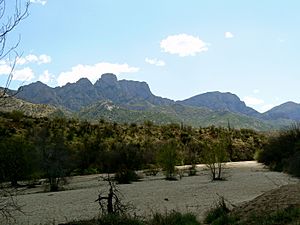
- Steam Pump Ranch: This historic ranch dates back to the 1870s. It's being preserved by the town and has original buildings. It's listed on the National Register of Historic Places.
- Catalina State Park: Located on N. Oracle Road, this park has many trails for hiking and backpacking. Some trails connect to the Coronado National Forest and go up to Mount Lemmon, the highest peak in the Santa Catalina Mountains. The park also has campgrounds and an equestrian center for horses.
- Immaculate Heart Preparatory School: This school is in a former mansion built in 1937. It used to be the winter home of Margaret Howard, the Countess of Suffolk from the United Kingdom.
- Honey Bee Village: This is where the Native American Hohokam people lived around 500 AD. The ruins are preserved by the town.
- Canyon del Oro High School: Built in the early 1960s, this high school is a community center for the town. It's located right next to Pusch Ridge.
- Oro Valley Public Library: This library is in the heart of Oro Valley, with views of the golf course and Pusch Ridge.
Local News and Media
Oro Valley is served by several publications that share local news:
- "OV Style Magazine": A monthly magazine about lifestyle, events, and businesses in Oro Valley.
- Arizona Daily Star: A daily newspaper.
- The Explorer: A free weekly newspaper covering Oro Valley and nearby areas.
- Tucson Weekly: An alternative publication distributed for free.
The town also receives television channels from Tucson, including KVOA 4 (NBC), KGUN 9 (ABC), KOLD 13 (CBS), and others.
Famous People from Oro Valley
- Alex Bowman – A professional stock car racing driver.
- Ka'Deem Carey – A professional football player.
- Eli Crane – A U.S. representative.
- Chris Duncan – A professional baseball player.
- Shelley Duncan – A baseball player.
- Scott Hairston – A professional baseball player.
- Ian Kinsler – An Israeli-American professional baseball player.
- Blake Martinez – A professional football player.
- Lionel Sanders – A professional triathlete.
See also
 In Spanish: Oro Valley (Arizona) para niños
In Spanish: Oro Valley (Arizona) para niños






